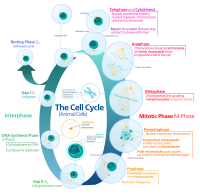
Photo from wikipedia
Cell division is a fundamental biological process that has been extensively investigated in different systems. Similar to most eukaryotic cells, plant cells assemble a mitotic spindle to separate replicated chromosomes.… Click to show full abstract
Cell division is a fundamental biological process that has been extensively investigated in different systems. Similar to most eukaryotic cells, plant cells assemble a mitotic spindle to separate replicated chromosomes. In contrast, to complete cell division, plant cells assemble a phragmoplast, which is composed of aligned microtubules and actin filaments. This structure helps transport vesicles containing new cell wall material, which then fuse to form the cell plate; the cell plate will expand to create the new dividing cell wall. Because vesicles are known to be transported by myosin motors during interphase, we hypothesized this could also be the case during cell division and we investigated the localization of the plant homologue of myosin V - myosin XI, in cell division. In this work, we used the protonemal cells of the moss Physcomitrella patens as a model, because of its simple cellular morphology and ease to generate transgenic cell lines expressing fluorescent tagged proteins. Using a fluorescent protein fusion of myosin XI, we found that, during mitosis, this molecule appears to associate with the kinetochores immediately after nuclear envelope breakdown. Following metaphase, myosin XI stays associated with the spindle's midzone during the rest of mitosis, and when the phragmoplast is formed, it concentrates at the cell plate. Using an actin polymerization inhibitor, latrunculin B, we found that the association of myosin XI with the mitotic spindle and the phragmoplast are only partially dependent on the presence of filamentous actin. We also showed that myosin XI on the spindle partially overlaps with a v-SNARE vesicle marker but is not co-localized with the endoplasmic reticulum and a RabA vesicle marker. These observations suggest an actin-dependent and an actin-independent behavior of myosin XI during cell division, and provide novel insights to our understanding of the function of myosin XI during plant cell division.
Journal Title: Biochemical and biophysical research communications
Year Published: 2018
Link to full text (if available)
Share on Social Media: Sign Up to like & get
recommendations!